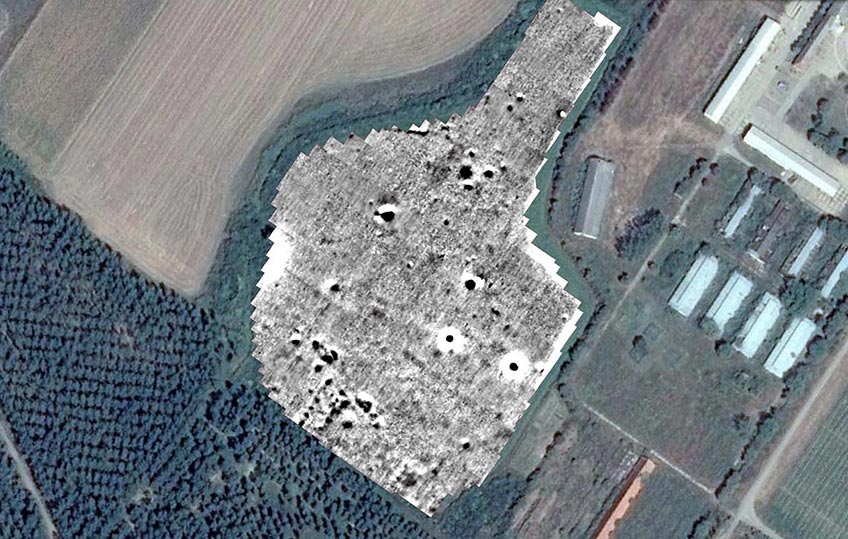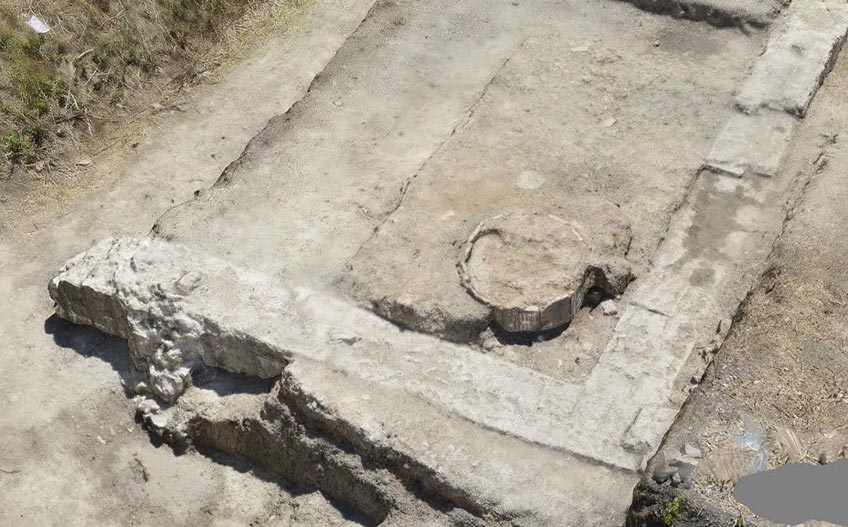Excavation 2017
Iskopavanje 2017
The 2017 season took place during the second half of June and first half of July. The aim of the initial campaign was to define the surface of the complex of the late Roman villa. The research was based on two components, excavations and survey of the immediate surroundings of the site.
Kampanja istraživanja 2017. godine odvijala se tokom dve nedelje krajem juna i početkom jula. Cilj početnih istraživanja na lokalitetu Glac sastojao se u definisanju površine kompleksa kasnoantičke vile. Istraživanja su se odvijala u dva pravca. Jedan su činila sondažna iskopavanja, dok je drugi deo predstavljala prospekcija neposredne okoline lokaliteta.

Geofizički snimak lokaliteta Glac
A geophysical survey showed that the remains of the buildings spread in the direction of NW-SE, mostly underneath the field, and that parts of the complex could extend underneath the forest to the south and beneath Mitrosrem agricultural company’s land. A geo-radar survey on a smaller surface was conveyed by our colleagues from the Centre for New Technologies and it established the existence of walls on the south-eastern side of the site, stretching towards the northwest. These findings lead to the conclusion that the villa complex extends for more than six hectares.
Unfortunately, in recent decades, digging deep ditches damaged the Roman architecture in several places. This was determined by finds of the remains of floors made of hydrostatic mortar and bare walls.
Geofizički snimak iz 2014. godine pokazao je da se ostaci građevina prostiru u pravcu SZ-JI u najvećem delu ispod njive, ali i da postoji mogućnost da se delovi kompleksa prostiru ispod šume ka jugu i ispod ekonomije Mitrosrem prema istoku. Uz pomoć kolega iz Centra za nove tehnologije ove godine je geo-radarom snimljena manja površina. Rezultati su pokazali da se zidovi konstatovani na jugoistočnoj strani lokaliteta prostiru i na severozapadu, što je i dovelo do proračuna da je ceo kompleks kasnoantičke vile na Glacu obuhvatao prostor od oko 6 hektara.
Nažalost u prethodnim decenijama su moderni ukopi dubokih rovova na nekoliko mesta oštetili rimsku arhitekturu, što je utvrđeno nalazima ostataka podova od hidrostatičkog maltera i ogoljenih zidova. Kako je na pojedinim mestima antička arhitektura bila vidljiva iznad površine tla iskopi su bili postavljeni neposredno uz nju.

Zid 1 – južna strana lokaliteta
The first goal of the 2017 season was to examine the wall on the south side, visible for a length of more than 80 meters, as well as the ditch that existed next to it. It is our current assumption that this was an external wall of one of the monumental buildings that was typically part of a late ancient palatial complex. The wall is of high quality masonry with regularly shaped ashlars and bricks.
Prvi zadatak u istraživanjima 2017. godine bio je da se ispita zid na južnoj strani lokaliteta, koji je bio vidljiv i pre istraživanja u dužini od preko 80 metara, s obzirom da je uz njega ranije iskopan rov. Za sada se pretpostavlja da je predstavljao spoljni zid neke od monumentalnih građevina koje su postojale u kompleksima kasnoantičkih palata. Njega odlikuje kvalitetno zidanje pravilno oblikovanim tesanicima i opekama.

Sonda 1 – ostaci zida sa otvorima
Openings on the wall were noted at equal distances. To the north of the wall there are a series of rooms and we therefore assume that these openings had the purpose of a drainage. On the north side of the wall, in the modern ditch, the remains of the juncture of two massive walls with bricks were discovered. A special kind of tile (tegula mammata), commonly used for wall heating, was discovered inside one room.
Na određenim rastojanjima na zidu su uočeni otvori. Severno od zida protezali su se nizovi prostorija i stoga se pretpostavlja da su otvori u zidu imali namenu kanala za odvod. Na severnoj strani lokaliteta, u iskopu modernog rova, otkriveni su ostaci spoja dva moćna zida u čijoj izgradnji su korišćene opeke. Unutar prostorije otkrivena je posebna vrsta tegule (tegula mammata) koja je uobičajeno korišćena za izgradnju sistema zidnog grejanja.

Mozaik u jednoj od prostorija vile
Remains of a plaster floor decorated with a floor mosaic were found in one of the northern rooms. The mosaic consists of colourful tesserae forming various geometrical forms (vines, braids, complex geometrical patterns) characteristic of late antique floor decorations. A destruction horizon was recognised in several places. Above the mosaic floor a hand, fragment of a marble sculpture that could originally have been portraying a Roman deity, was uncovered in spoils. In Trench 1, several finds indicate the deterioration period of the villa. A wall decorated with frescoes and traces of luxurious marble decoration were found above the floor. A child’s grave was discovered in the same room, which indicates that by the end of the 4th or beginning of the 5th century this space was no longer inhabited and that its ruins became a burial site.
U jednoj od severnih prostorija otkriveni su ostaci malternog poda ukrašenog podnim mozaikom. Sačinjen je od raznobojnih kockica (tesselae) koje su bile raspoređene u obliku različitih geometrijskih motiva (vreže, pletenice, kompleksni geometrijski motivi) karakterističnih za podne ukrase kasne antike. Horizont destrukcije vile prepoznat je na nekoliko mesta. Nad mozaičkim podom u moćnom šutu otkrivena je odlomljena šaka, deo mermerne skulpture za koju bi se moglo pretpostaviti da je izvorno prikazivala neko rimsko božanstvo. U sondi 1 nekoliko nalaza ukazuje na period zamiranja vile. Nad podom je otkriveno zidno platno ukrašeno freskama, a nad podom brojni opiljci nastali obradom skupocenog mermera. U istoj prostoriji otkriven je dečiji grob koji nam pouzdano svedoči da je negde krajem IV ili možda tokom V veka ovaj prostor prestao da ima naseobinski karakter i da su se u ruševinama vile sahranjivali pokojnici.

Prostorija sa ostacima kasnoantičke peći
Another interesting find was uncovered in the series of rooms, north of the massive wall – a pottery kiln with a clay floor surrounded by Roman bricks. Further excavations will show whether this part of the complex was used for industry, or if the kiln was built in the later period when the villa lost its residential character. A find of a coin of Emperor Justin II, minted in Nicomedia (Asia Minor) in 572 AD, is a significant find that shows that the site was a settled over a longer period of time.
In some areas, it was possible to examine the earliest stages of the site that suggest a smaller settlement existed there prior to the late ancient villa. The strongest indicators for this are the findings of fragments of ceramic dishes in La- Tene forms, and even younger ones from the 2nd and 3rd centuries.
During the excavations, a preliminary survey of the immediate surroundings of the Glac site was carried out. The purpose of this investigation was to potentially detect the remains of ancient communications and other complexes that could exist in the vicinity of the villa and suburbs of Sirmium. There are currently indicators that point to the possibility that the road in the direction of Sirmium-Glac-Fossae was positioned north of the villa. There could also be a route that led from Sirmium to Jarak, right next to the coast, between the villa and Sava River. Further research, planned for the season of 2018, will tackle these unresolved questions.
U nizu prostorija severno od obimnog zida vile otkriven je još jedan zanimljiv nalaz. To je peć čiji je pod načinjen od gline, a osnova okružena rimskim opekama. Buduća istraživanja će pokazati da li se u ovom delu odvijala zanatska delatnost ili je peć nastala u poznijem periodu kada vila gubi rezidencijalan karakter. Jedan značajan nalaz svedoči o dužem periodu u kojem je lokalitet predstavljao naseobinu, a to je novčić cara Justina II iskovan u Nikomediji (Mala Azija) 572. godine.
Na pojedinim mestima bilo je moguće ispitati najranije faze lokaliteta koje upućuju na to da je pre nastanka kasnoantičke vile, na ovom prostoru mogla postojati manja naseobina. Najjasniji pokazatelj za to predstavljaju nalazi fragmenata keramičkog posuđa latenoidnih formi, ali i nešto pozniji iz perioda i drugog veka i trećeg veka.
Tokom iskopavanja je obavljena i preliminarna prospekcija neposredne okoline lokaliteta Glac. Cilj ovih ispitivanja bio je da se eventualno uoče ostaci antičkih komunikacija, ali i drugih celina koje su mogle postojati u neposrednoj blizini vile i predgrađa Sirmijuma. Za sada prvi pokazatelji ukazuju na mogućnost da se put na pravcu Sirmijum-Glac-Fossae nalazio severno od vile. Takođe je mogao postojati i put koji je vodio od Sirmijuma ka Jarku neposredno pored obale između vile i Save. Dalja istraživanja planirana za kampanju 2018. godine jasnije će osvetliti ova nerazrešena pitanja.
2017 Team
2017 Tim
Professor Richard Miles – Project Co-Director
Dr Stefan Pop- Lazić – Project Co-Director
John Whitehouse – Survey Lead
Dr Milijan Dimitrijević – Archaeological Survey and Field Archaeologist
Zorana Kataranovski – Project Administrator
Bernadette McCall – Area Supervisor
Dr Duncan Keenan-Jones – Coordinator of environmental and geoarchaeology research
Dr Andrew Yip – UAV pilot and 3D recording specialist
Mr. Sci. Dragana Nedeljković – Bioarchaeological material processing
Miroslav Jesretić – Numismatics
Jasmina Davidović – Coordinator of pottery and stone objects processing
Vujadin Vujadinović – Area Supervisor/Documentation
Milica Tomić – Technical Documentation
Sanja Treskanica – Small finds documentation
Simon Greenslade – Area Supervisor
Claudia Goodbrand – Finds Specialist and Area Supervisor
Dr Alan Dearn – Finds Coordinator
Sonja Štefanski Zorić – Pottery processing
Svetlana Gojković – Conservator
Slobodan Maksić – Video documentation
Jelena Šarović – Student
Zvezdana Štimac – Student
Byron Waldron – PhD Student
Profesor Ričard Majls – Ko-direktor projekta
Dr Stefan Pop-Lazić – Ko-direktor projekta
Džon Vajthaus – Rukovodilac rekognosciranja
Dr Milijan Dimitrijević – Rekognosciranje i terenski arheolog
Zorana Kataranovski – Administratorka projekta
Dr Bernadet Mekol – Rukovodilac sektora
Dr Dankan Kinan Džouns – Koordinator istraživanja arheologije životne sredine i geoarheologije
Dr Endru Jip – Operater bespilotne letelice i 3D dokumentacija
Mr Dragana Nedeljković – Obrada bioarheološkog materijala
Miroslav Jesretić – Numizmatika
Jasmina Davidović – Koordinator obrade proizvoda od keramike i kamena
Vujadin Vujadinović – Rukovodilac sektora/dokumentacija
Milica Tomić – Tehnička dokumentacija
Sanja Treskanica – Pokretni nalazi
Sajmon Grinslejd – Rukovodilac sektora
Klaudija Gudbrend – Specijalista za nalaze i rukovodilac sektora
Dr Alan Dern – Koordinator pokretnih nalaza
Sonja Štefanski Zorić – Obrada keramike
Svetlana Gojković – Konzervator
Slobodan Maksić – Video dokumentacija
Jelena Šarović – Studentkinja
Zvezdana Štimac – Studentkinja
Brjron Voldron – Doktorant

